20 Best Innovation Management Tools – Choosing the Right One
If you're here for just the list of 20 best innovation management tools, click the link to jump directly there. However, we strongly recommend you read on to find out why and how of successfully choosing and using an innovation management tool.
Innovation management has been a hyped topic in the past decade or so due to its value in bringing game-changing ideas and molding the way we do business. From getting ahead in your industry to utilizing the creativity of your work force, managing innovation is something to be aware of.
For a quick recap in terminology, innovation management is not to be mixed with idea management, although some may think they are synonyms. Idea management refers to managing ideas themselves, and although the grand goal is to ultimately create something usable, the concept covers the act of gathering and developing ideas. Innovation management, on the other hand, refers to the broader act of sculpting ideas into actual innovations. The actual process that takes an idea from its infancy into a successful product or service.

Innovation management doesn’t just happen on its own. Just like a ship needs sails along with a dedicated captain and crew who know how to use them, managing innovation requires a tool and motivated people to use it. A dedicated tool for innovation management is a tremendous help in achieving concrete results for your efforts, as well as keeping the entirety of ideas, discussion, categorization, and process manageable.
"Just like a ship needs sails and a crew, managing innovation requires a tool and motivated people to use it."
For this reason, as a part of our innovation management post campaign, we’ve decided to write this comprehensive article on finding the right tool for managing innovation.
Table of Contents
Why Is Innovation Management Important?
So why is innovation management so important you cannot walk two steps without hearing the word?
Before I understood the concept, I also perceived it as just business lingo that doesn’t really have much to do with anything tangible. But that was just because I didn’t understand it well enough or how crucial doing it with intent and determination is for a company to thrive in the long run.
Now, let me share the wisdom from countless hours of research and firsthand experience with customers.

Incremental vs Radical Progress
Especially larger companies often solely focus on developing their products and services in an incremental and sustaining manner. The problem with doing so is that it is safe and much easier than giving breathing room for any new idea to grow, be the idea however radical. In fact, one common factor among companies pursuing incremental growth is that they lack innovation.
Not only in the sense that it doesn’t exist to begin with, but actually inhibiting it. New and bold ventures are downright discouraged through quarterly quotas and oversight to maximize efficiency.
A conscious effort to manage innovation is a necessity for creating an environment where new, radical or even disruptive ideas can be brought to life. Without it, many groundbreaking ideas will never see the light of day.
Of course, not to sound naive, for a large organization to suddenly adopt innovation it requires much more than just making the choice to do so, but that’s another topic entirely. To focus on the broader point, the fact of the matter is that innovation management is crucial if you wish to create something new and not just build another layer on the old until it looks like the leaning tower of Pisa.
Innovation management is crucial if you wish to create something new and not just build another layer on the old until it looks like the leaning tower of Pisa.

This brings us to our next point, sustainability.
Staying Ahead of the Curve
It is an inevitable fact that organizations which lack innovation are fragile when you zoom out in the scale of time. It is a bumpy road in terms of sustainability if all efforts are towards reaching a comfortable plateau in incremental growth and paying shareholders their dividends. Instead efforts should be steered towards investing in growth to avoid the being overthrown by something better and more efficient when the current product or service is no longer able to keep up with time.
Innovation management (read, “innovation”) increases adaptability. It is a way to not only keep the current product or service competitive, but also a gateway to even being at the frontier of building something game-changing yourself.
For example, Nokia was at the forefront of developing the still rudimentary touch-screen technology and combining it with a functioning smartphone while Apple and Samsung were still considered infants in the phone industry. However, instead of leading the smartphone race, the colossus crashed due to a slow reaction to a new reality in the handset game. Instead of executing increasingly bolder moves and developing and trying on all fronts (in their case, platforms) – as should be done in the face of radically changing market – they trusted the old platform and their status to keep them afloat. In hindsight, the signs were there and so were the creativity, brainpower and resources to push through; even come out stronger on the other end. They were only missing the ability and knowhow to manage it.

Using All Available Resources
This one may be obvious, however still quite an important point to make.
Simply put, it would just be pointless not to use all that raw creativity lurking in the silent masses of the organization. Instead of letting it go to waste, or rather not utilizing it, wouldn’t it be wiser to do something about it?
Many smaller firms or startups rarely have enough collective knowledge or creativity to go around. Thus, it wounds to see huge organizations that have the ability to think 5 steps ahead and see them settle for 1.
"It wounds to see huge organizations that have the ability to think 5 steps ahead and see them settle for 1."
So, where do we go from here?
Now that we know innovation management is important, how do we put this exciting information to use and make it happen?
Well, you don’t start handing out post-it notes and yell: “Innovate people!” unless you really enjoy gathering crumbled up post-its in your office.
By far the best and easiest solution is using a specifically designed tool for managing innovation, and there are a lot of tools out there. This just ignites the dilemma of “How do I know which tool is the right one?” Well, read on to find out!
Next in turn is our best list of innovation management tools on the web.
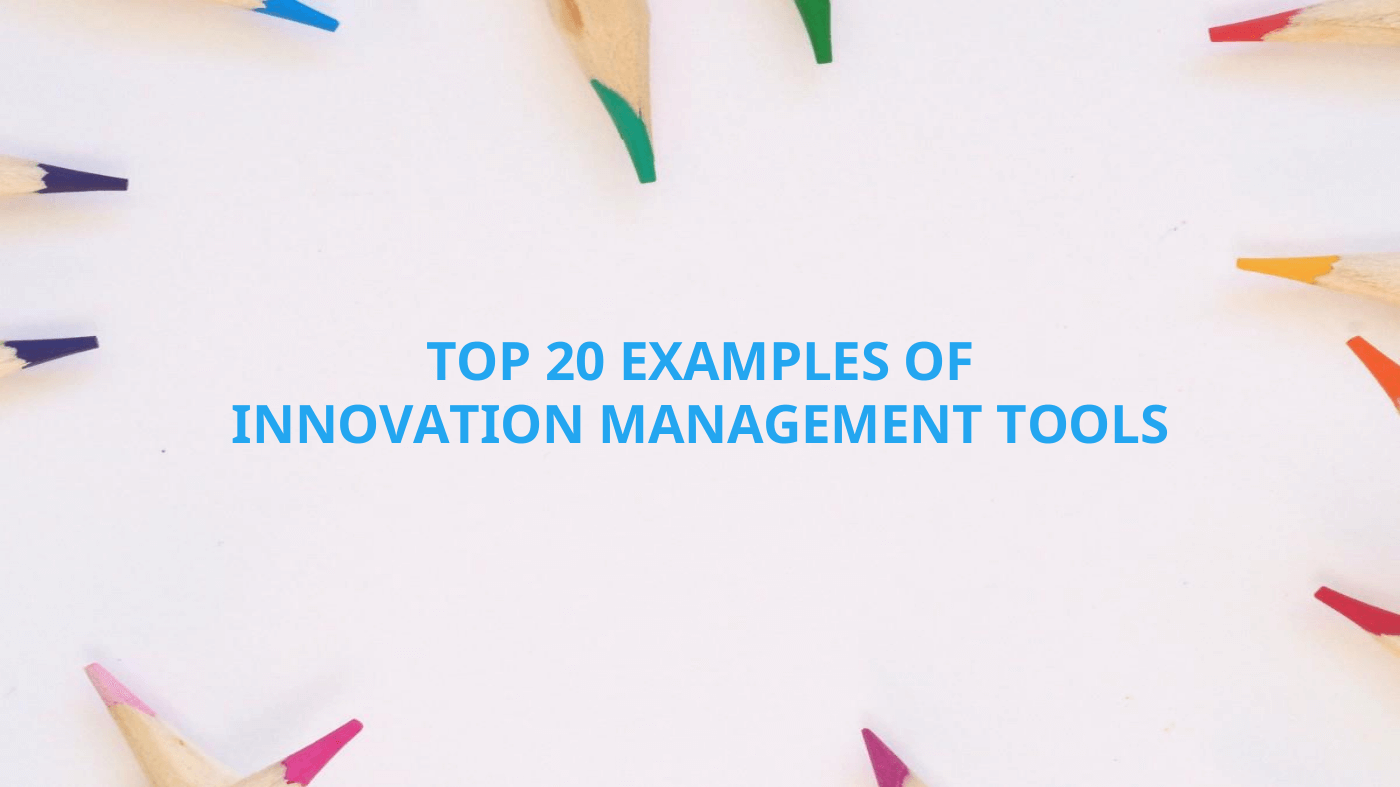
We’ve gathered the 20 best innovation management tools that exist. We’ve done the research for you! All you need to do is read on and find out which ones pique your interest.
For the first nine more popular tools we have added descriptions on who the tool is suitable for and pros and cons lists to aid you in your decision. In addition, we've also looked up which ones offer free trials and/or versions.
By free trial, we mean a demo of the product for a fixed time, whereas a free version can be used indefinitely but with limited features or capacity.
1. Qmarkets
Qmarkets is an enterprise software that is designed to work as a complete innovation management package for larger organizations. Although it may be able to do some heavy lifting in terms of innovation management, it falls short in the areas of intuitive use for the end user.

Pros:
- Flexible customer service that is ready at a moment’s notice
- Good reporting on platform activity statistics
- Reponsive content management
Cons:
- Unintuitive due to a heavy feature load
- Requires extensive knowledge to use
- Mobile version doesn’t work well
- Problems with multi-language support
Free version: No
Free trial: Yes
2. Ideawake
Ideawake is designed as a precision innovation management tool that is good for beginners. Where it lacks in features, it makes up for in practicality. However, larger organizations may find this tool insufficient for versatile needs.
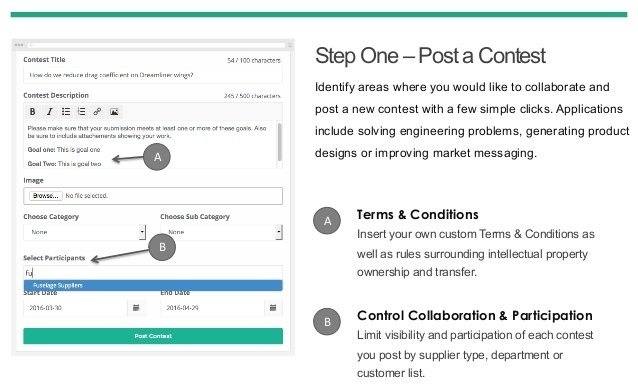
Pros:
- Doesn’t require extensive implementation projects to get started with
- Allows people from different functions to connect and work together
- Visually pleasing platform
Cons:
- Limited in terms of features and possible use cases
- Does not have a process for evaluating ideas based on their viability
- Minor problems & bugs may be encountered in use due to a lacking internal testing process
Free version: No
Free trial: Yes
3. Viima
Viima is an all-in-one innovation management tool which can easily be used by from startups to larger organizations. Viima stands out of the bunch in its ease of use and visual appearance that help keep participants motivated and intrigued. Viima has been designed to be an intuitive self-service SaaS tool, but also includes access to experienced and quick-responding customer support.
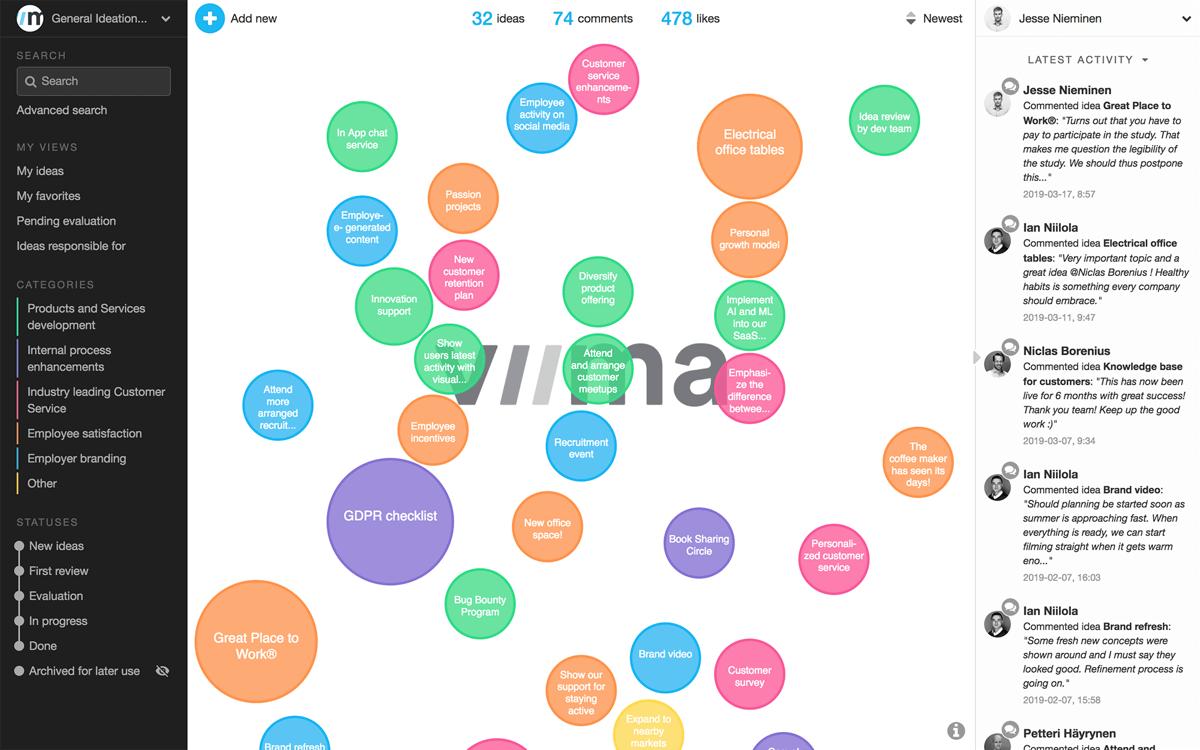
Pros:
- A scalable innovation management process that customer admin users can maintain and develop first hand
- Intuitive & engaging UI that helps maximize user participation levels and thus drives results
- Starting out doesn’t require any previous knowledge and is the quickest to implement
Cons:
- Mobile UI doesn’t yet support all of the features of the desktop browser version
- Doesn’t support customer specific subdomain addresses
- Tutorial videos are not publicly available but instead require registration to the service before hand
Free version: Yes
Free trial: Yes
4. Inno360
Inno360 is an innovation management software that specializes in creating disruptive innovation in an organization by searching for opportunities and ideas on the web. While this approach is fresh in terms of using the web to create new disruptive ideas, in terms of usability the platform isn't designed for heavy internal innovation.
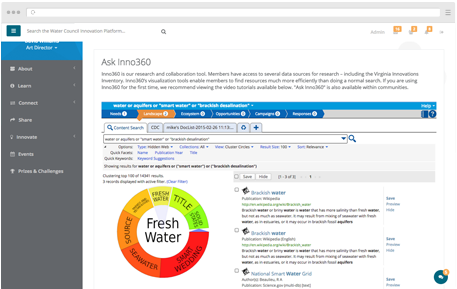
Pros:
- Helps find new and bold ideas
- Intuitive & visually engaging platform
- Doesn’t heavily rely on internal participation
Cons:
- Not good for managing internal innovation
- Cannot be used to engage employees
- A very limited way of using that mainly relies on utilizing existing information
Free version: No
Free trial: Yes
5. Co:tunity (InnoFunnel)
While Co:tunity's InnoFunnel is more of an idea management tool, it is included in this listing due to its versatility. Co:tunity works well when customized for smaller projects. However, is not designed for heavy lifting due to the structure of the workflow.
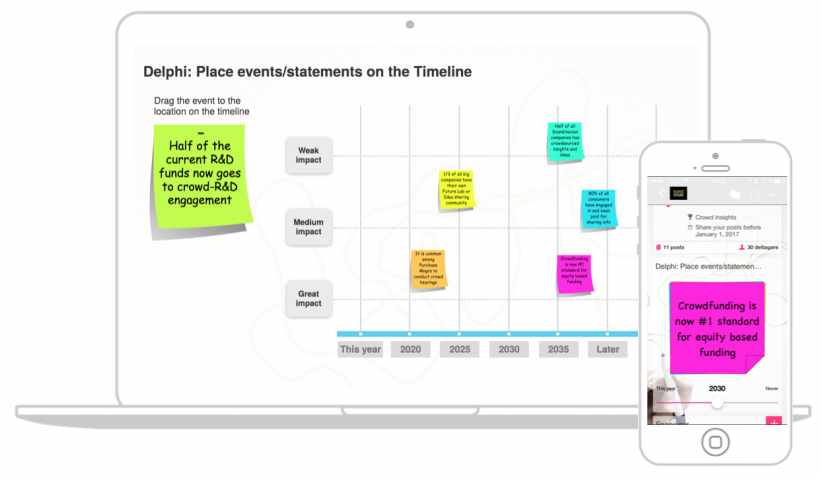
Pros:
- Engaging platform with a nice design
- Knowledgeable & active customer service
- Easy to use for smaller firms or projects
Cons:
- Difficult to scale up due to shortage of features and inflexibility of the idea management process
- Advanced features are difficult to use
- Unintuitive admin settings require training to get started
Free version: Yes
Free trial: Yes
6. Accept Mission
While Accept Mission is also an idea management tool, due to its unique nature, we decided to include it in this listing as well. Accept Mission is a brainstorming tool that specializes in using a gamifying approach to get people innovating. Although it makes participation fun, it is unfortunately quite limited in it flexibility and versatility.
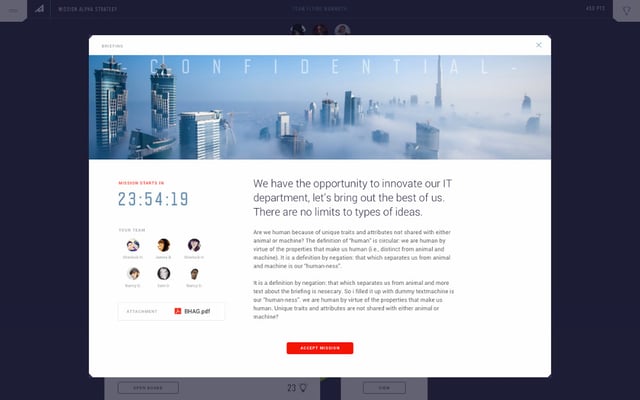
Pros:
- A gamifying approach that makes ideation fun
- Engages employees and ignites conversation
- Enables high participation and retention for a time
Cons:
- Very restricted in terms of workflow flexibility and use case versatility
- May seem childish or unnecessarily flashy for some
- Not build for scaling up
Free version: Yes
Free trial: Yes
7. Exago SMART
Exago SMART is an enterprise innovation management software that offers ready solutions for various use cases. Although it works well for the given purpose even with a large number of people, it lacks in customizability.
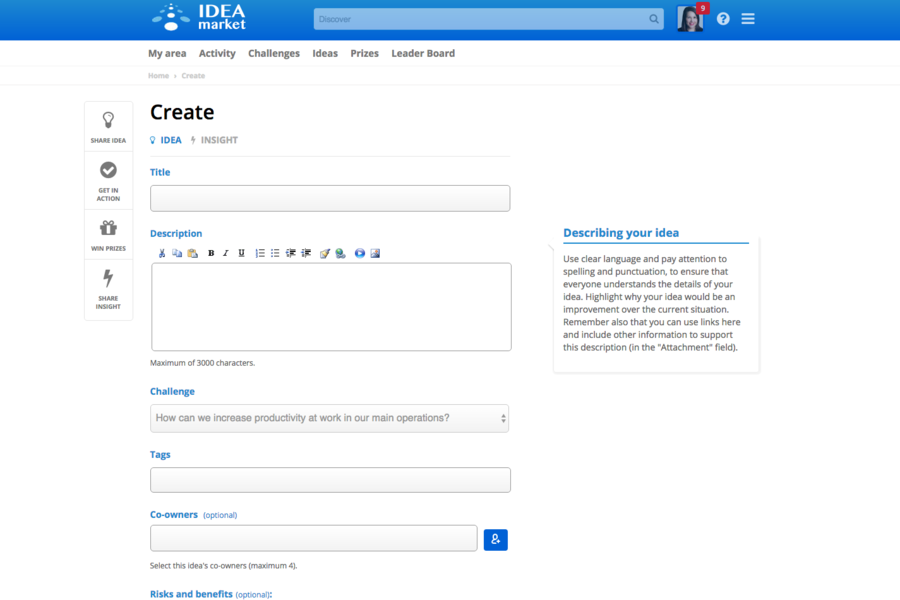
Pros:
- Easy to use after the necessary set-up has been done
- Works well for the intended use case
- Engages employees and incites conversation
Cons:
- Heavy feature load makes it difficult to customize and use outside the intended bounds
- Set-up requires time and resources; cannot be done autonomously
- Not cost-effective for smaller organizations or projects
Free version: No
Free trial: Yes
8. Crowdicity
For an idea management tool, Crowdicity is also equipped for innovation management. However, where it specializes in flexibility and practicality, it lacks in versatility. All features are designed to keep the customer experience effortless. Although this is good for a specific use case, an additional tool is needed if you want to expand your scope of innovation management.

Pros:
- Responsive and helpful customer service
- Engaging and practical UI
- Can be visually customized to match your brand
Cons:
- Difficult to scale for other use cases than direct brainstorming
- Lacking in multi-language support
- Poor reporting & analytics on platform related activity
Free version: No
Free trial: Yes
9. IdeaScale
IdeaScale is an idea management tool that alike for innovation management, focuses on providing an effortless set up and experience for users. Although it does these things well and with even a heavy participation, it isn’t designed for customizability. If you’re looking for an easy and fast way to set everything up, it does just that. If you think your innovation management goals might shift at some point, it may require an additional tool.
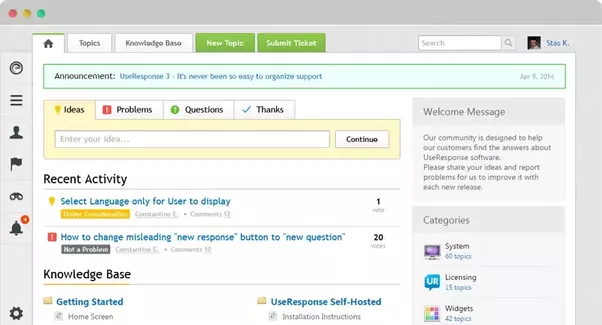
Pros:
- Practical UI makes it easy to get started and use
- Does straightforward idea management well
- Active customer support
Cons:
- Difficult to customize for specific needs
- Managing settings is not intuitive
- Some important features are only available in expensive plans
Free version: Yes
Free trial: Yes
Other innovation management tools you may find interesting:
10. Inteum
11. Favro
12. Idea Drop
13. Babele
14. Innovation Platform
15. HYPE Innovation
16. SoapBox
17. OneDesk
18. SAP Innovation Management
19. iEnabler
20. @Work
Choosing The Right Tool
Didn’t find the perfect one on the list?
Finding the right tool isn’t always as easy as picking one off a list. It can be a tenacious process when done with care, yet quite simple when you break it down to its elements.
This is why we’ve decided to also include a process of finding the best tool for your specific needs:
- Chart & prioritize your goals
- Research & shortlist vendors
- Start piloting
- Keep at it!
Chart & Prioritize Your Goals
The logical first step is to take a breather and ask yourself: “What do you wish to achieve?” Besides the broader agendas, such as: aiming to stay competitive and agile, what are the smaller and more achievable things in your scope? Write them down and give it some time.
This is an important reflection in the beginning of the process as it aids in finding a tool with the right characteristics and features earlier on. Also, this helps understand your industry-specific goals better.
For example, if we’re talking about a software company that has high reliance on crowdsourcing, the tool should definitely allow very transparent ideation. However, if a microchip company only wishes to gather employee input on a secretive product, it’s best to have the option of making the platform airtight.

Research & Shortlist Vendors
Now, with the strategic goals clear in your head, it’s time to start doing research on vendors and what they’re offering. This takes time and may even be a little stressful, however, it’s best done with care as to not be blindsided later on.
Although we recommend using our list in the sense that we've cherry-picked the best of the best, if you didn't find one on it that clicks, other impartial lists with innovation management tools from A to Z can be found online (For example, Capterra). I recommend you read objective reviews, get familiar with the features, characteristics and use cases, and keep an eye out for free versions.
Although our first and foremost goal is to help you find the vendor that suits your needs best, naturally we at Viima feel that ours is the best tool out there for just about any use case and can back up that claim by offering a free Basic plan that you can use with an unlimited number of people.
After you’ve gathered enough candidates, shortlist the most promising ones and we are ready for lift-off.
Start Piloting
This is the part where it gets fun!
It’s time to start trying out the software, one at a time if need be. From experience, it may take a few tries to find the right one. However, you shouldn’t eliminate the possibility of finding it right off the bat.
Finding software with free versions or trials comes in handy as this makes it easier to try them out without commitment. Also, free versions are a good indicator that the vendor believes in their software enough to get you hooked.

Keep At It!
Although the earlier step might’ve felt like a logical end to the process of finding the right tool for innovation management, this is one is crucial in terms of increasing the possibility of one day finding said tool.
In other words, it may end up being an exhausting ride if the perfect tool just doesn’t seem to exist.
All I can say is: “Keep at it!” You will get there one way or the other. However, if you try out dozens of tools with intent to succeed and still are left staring at empty palms, it might be worth it to go back to the drawing board with your goals and tune them to be more achievable, (not that setting the bar high is ever a bad thing.)
The worst thing you can do is give up on trying to find it or start your pilot with a freefall mentality: “It will take care of innovation for me.”
It won’t.
The reality is that whether you find your chosen tool or not, it’s hands-on work if you wish to succeed. In the next chapter I’ll show you how to muster through once you find something that potentially sticks.
But before that, here's a quick recap: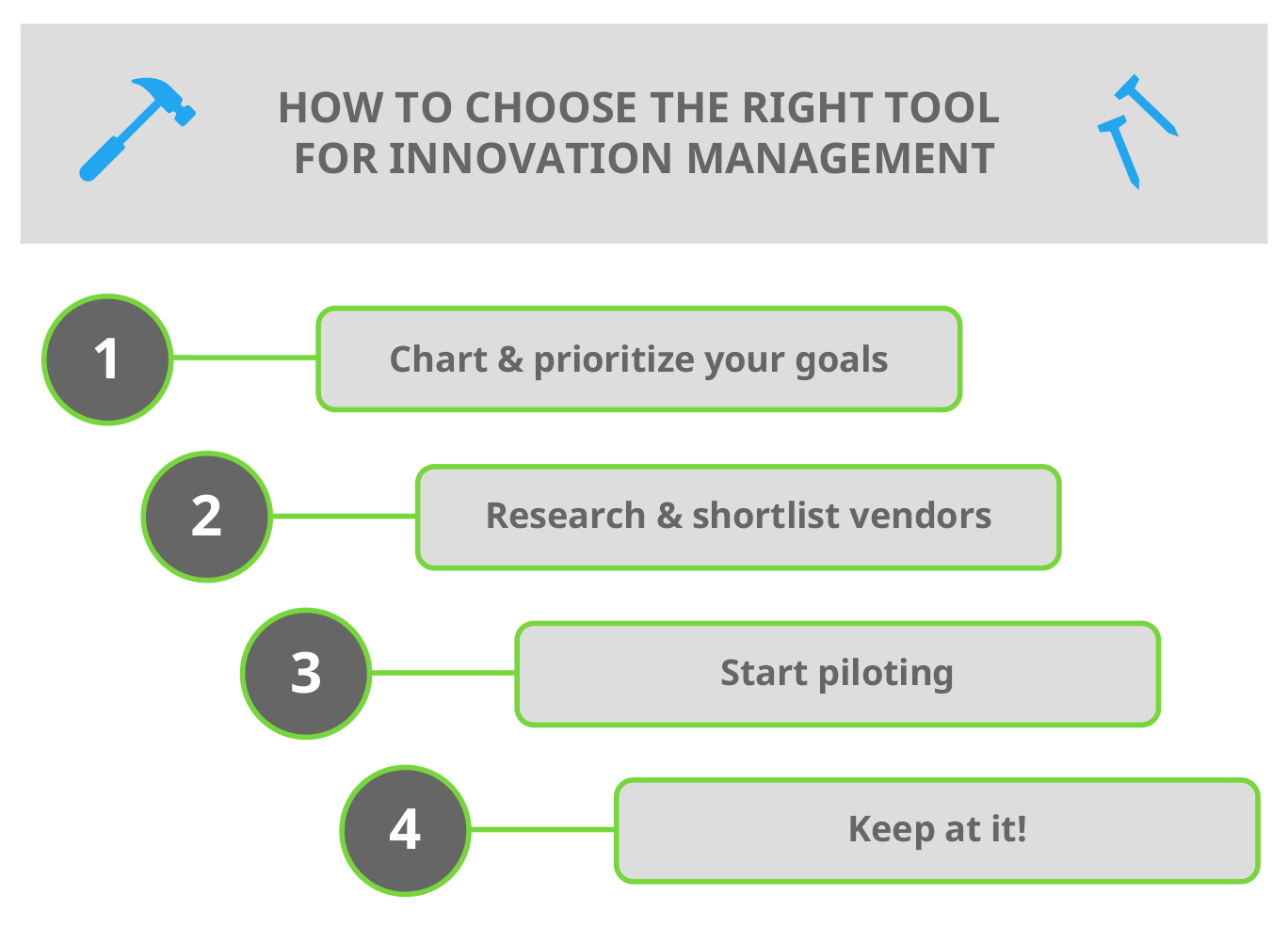
Using an Innovation Management Tool
Okay, let’s say you now have a tool at your disposal that seems to do just about everything you want it to. Like us at Viima, they may even be open to making special arrangements to customize it for your specific needs.
How do you get it to work in the long run? What if people lose interest or nothing tangible ever sprouts?
If people lose interest or nothing useful comes out, there are two possible reasons for this: One, you’re doing it wrong. Two, you have the wrong tool
Both can be fixed by making a course correction. If the tool is too inhibiting, go back to the process of finding a tool and find another one. If the tool does anything you want and more, the problem is probably on your end.
It is hard to draw a fully generalized guideline for the best practices in using an innovation management tool. However, the following things work in most cases:
- Re-evaluate your goals: Crystallize your strategic priorities as to what you wish to achieve with the tool?
- Don’t manage it all yourself: Share responsibilities for different areas of process oversight and make the responsibilities clear. Do follow-ups.
- Build the hype: Don’t just send out a mass email stating that a tool now exists, it’s open, and you should use it. Give time for people to get excited. Use all channels at your disposal to blast (with finesse, of course) information about your new and exciting venture. Let them wait to participate and feel privileged to do so.
- Incentivize: Throw in incentives to motivate people. Of course, for many just getting to participate in making a difference is a huge motivator. However, pushing people to walk that extra mile may require a golden star. Avoid monetary incentives, such as gift cards, as these rarely work in the long run and motivate the wrong way. Instead use intrinsic incentives, such as “original ideator gets to be on the team to make the idea happen”, as these build real commitment.
- Check-ups: Make weekly or monthly check-ups a mandatory routine in your innovation management process. Ask the people of responsibility (which you have assigned) to compile information on their areas of responsibility and use this information to find out what works and what doesn’t. Build on what you learn.
- Don’t give up: This point is same as the last step in finding the right tool. However, it is just as relevant here. It is of paramount importance that you do not give up or think that the process or tool will take care of itself. That is when things will start to fall apart. Many failed ventures (often blamed on the tools) are due to the false notion that it will take care of innovation on its own. Only relentless dedication will get you to the finish line and beyond.
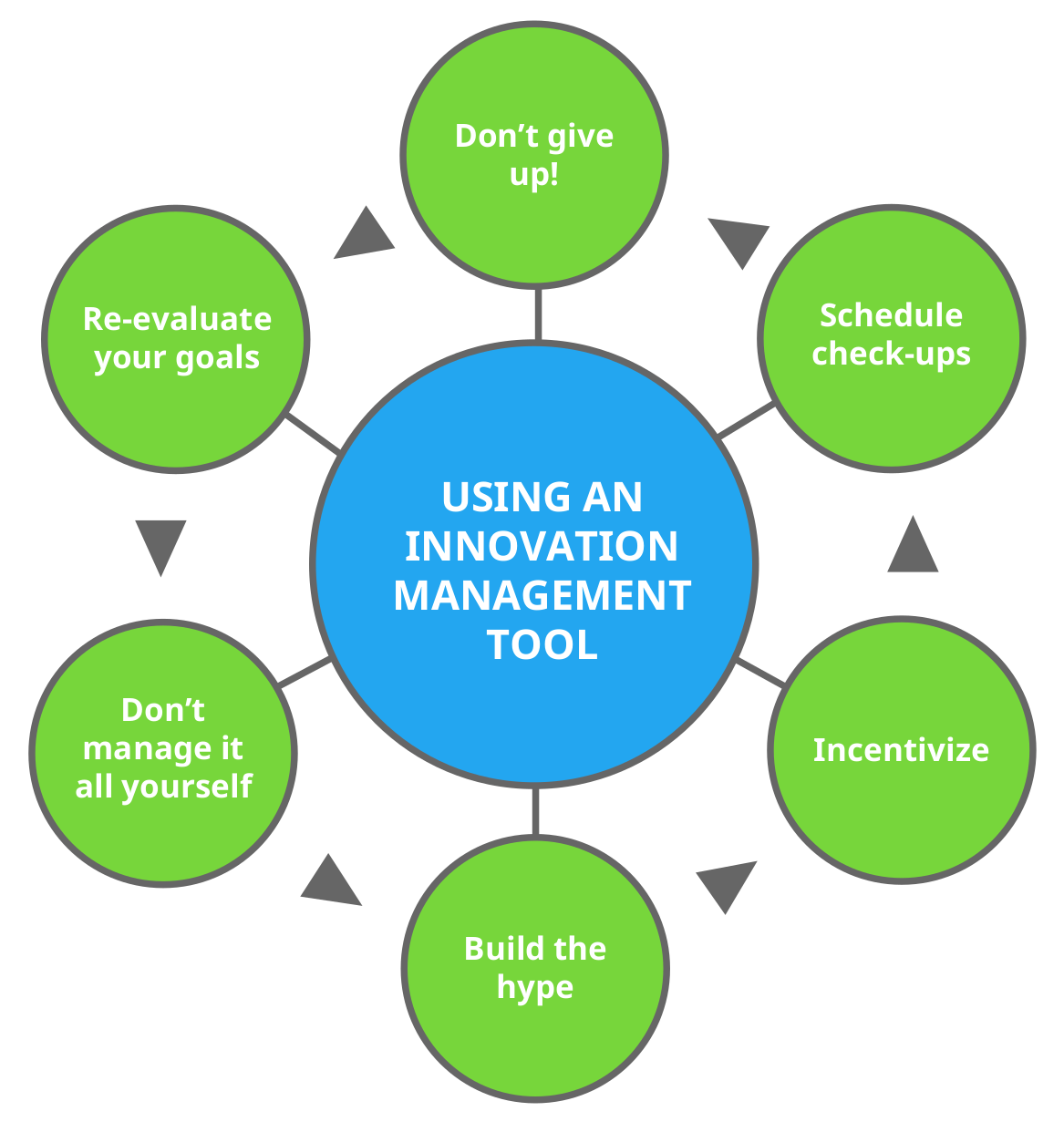
Final Thoughts
In a nutshell, finding the right tool requires research, patience and hard work. Once you get the ball rolling, it’s only a matter of time until you reap concrete benefits from your efforts.
I hope this thorough guide helps you find a tool that works for your needs. If at any point you feel lost or hit a dead end in your search for a tool, refer to this guide or contact our knowledgeable team. We’re always happy to help with all matters related to innovation.
Also, if you're interested in piloting an idea or innovation management software, you might want to refer to this guide, which has actionable tips and a checklist designed to help you in the process.






